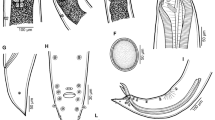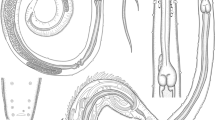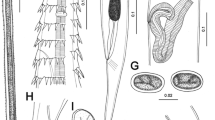Abstract
Purpose
Data on helminth parasites in hammerhead sharks are scarce and, therefore, new examinations of these hosts are needed to recognize the species composition of their parasites, including nematodes.
Methods
Helminthological examinations of hammerhead sharks, Sphyrna lewini (Griffith et Smith) (209 specimens) and Sphyrna mokarran (Rüppell) (57 specimens) (Sphyrnidae, Carcharhiniformes), from off the northern coast of Australia revealed one new and one insufficiently known species of intestinal nematode parasites. These were studied with the use of light and scanning electron microscopy.
Results
Both nematode species are described. Piscicapillaria bursata sp. nov. (Capillariidae) from S. mokarran (type host) and S. lewini differs from its congeners mainly in the spicule length (330 µm), body length of gravid females 12.80–21.26 mm and in possessing a subterminal female anus. The specimens of Parascarophis sphyrnae Campana-Rouget, 1955 (Cystidicolidae) (type species of Parascarophis Campana-Rouget, 1955) collected from S. lewini made it possible to redescribe the female and, for the first time, to describe the male; the same species was also found in S. mokarran. Amended diagnosis of Parascarophis is provided. Parascarophis is mainly characterized by the presence of lateral alae, a unique feature within the Cystidicolidae, and by the cephalic structures (presence of a cuticular hood and a pair of anterolateral plate-like structures in the mouth).
Conclusions
In addition to the discovery of a new nematode species, Pi. bursata sp. nov., the finding of Pa. sphyrnae in Australian waters represents a new geographical record of this parasite outside the Atlantic Ocean. The species of Parascarophis previously described from teleosts, P. bharatii Agrawal, 1965, P. oteroi Arya, 1992 and P. mulloidi Imam, Tawfik et Abdel Hady, 1982, are designated as species inquirendae and incertae sedis. The finding of P. sphyrnae in Australian waters represents a new geographical record of this parasite outside the Atlantic Ocean. Pa. sphyrnae had not been reported previously from beyond the Atlantic Ocean.






Similar content being viewed by others
References
Froese R, Pauly D (eds) (2019) FishBase. World Wide Web electronic publication. http://www.fishbase.org, version 01/2019
Naylor GJP, Caira JN, Jensen K, Rosana KAM, White WT, Last PR (2012) A DNA sequence-based approach to the identification of shark and ray species and its implications for global elasmobranch diversity and parasitology. Bull Am Mus Nat Hist 367:1–168
Moravec F (1982) Proposal of a new systematic arrangement of nematodes of the family Capillariidae. Folia Parasitol 29:119–132
Moravec F (1987) Revision of capillariid nematodes (subfamily Capillariinae) parasitic in fishes. Studie ČSAV no. 3. Academia, Prague
Moravec F (2001) Trichinelloid nematodes parasitic in cold-blooded vertebrates. Academia, Prague
Johnston TH, Mawson PM (1945) Capillariid nematodes from South Australian fish and birds. Trans R Soc S Aust 69:243–248
Johnston TH, Mawson PM (1951) Additional nematodes from Australian fish. Trans R Soc S Aust 74:18–24
von Linstow O (1914) Trichosoma tuberculatum n. sp. Zentralbl Bakt, Parasit, Infektionskrankh Hyg, I Abt Orig 73:395–396
Moravec F, Margolis L, McDonald TE (1981) Two new species of nematodes of the genus Capillaria (C. freemani sp. nov. and C. parophrysi sp. nov.) from marine fishes of the Pacific coast of Canada. Can J Zool 59:81–87. https://doi.org/10.1139/z81-013
Read CP (1948) A new capillariid nematode from the spiny dogfish, Squalus acanthius. J Parasitol 34:163–164
Moravec F, Barton DP (2018) Capillaria appendigera n. sp. (Nematoda: Capillariidae) from the goldbanded jobfish Pristipomoides multidens (Day) (Lutjanidae) and new records of other intestinal capillariids from marine perciform fishes off Australia. Syst Parasitol 95:55–64. https://doi.org/10.1007/s11230-017-9764-y
Moravec F, Beveridge I (2017) Lobocapillaria austropacifica n. g., n. sp. (Nematoda: Capillariidae) from the obtuse barracuda Sphyraena obtusa Cuvier (Sphyraenidae, Perciformes) off eastern Australia. Syst Parasitol 94:547–556. https://doi.org/10.1007/s11230-017-9722-8
Campana-Rouget Y (1955) Sur deux nouveaux genres de spirurides parasites de poissons; discussion systématique des genres voisins. Ann Parasitol Hum Comp 30:316–362
Skryabin KI, Sobolev AA, Ivashkin VM (1967) Spirurata of animals and man and the diseases caused by them. Part 4. Thelazioidea. Osnovy Nematodologii 16. Nauka, Moscow (In Russian)
Anderson RC, Chabaud AG, Willmott S (eds) (2009) Keys to the nematode parasites of vertebrates, Archival Volume. CAB International, Wallingford
Campana-Rouget Y (1956) Sur le genre Parascarophis Campana 1955 (Spirurinae–Nematoda). Ann Parasitol Hum Comp 31:665–666
Linton E (1905) Parasites of fishes of Beaufort, North Carolina. Bull Bur Fisher (1904) 14:321–428 (34 Plts)
Agrawal V (1965) Two new spirurid nematode parasites from freshwater fishes of India. Proc Helminthol Soc Wash 32:246–249
Arya SN (1992) A new species of the genus Parascarophis (Nematoda: Spiruridae), from a fish Bareilius vagra. Poeyana 418:1–4
Sood ML (2017) Fish nematodes from South Asia, 2nd edn. Kalyani Publishers, Ludhiana
Singha R, Singh MS, Kar D (2014) Parasite fauna in the wetland fishes of India. Today & Tomorrow Printers and Publishers, New Delhi
Sangeeta O, Shomorendra M, Kar D (2011) Studies on nematode parasites of fishes of Oinam lake Bishnupur district, Manipur, India. J Appl Nat Sci 3:264–267
Ampili M, Vishnu VK (2018) Prevalence of endoparasites in selected fish species. Int J Sci Res Publ 8:321–327. https://doi.org/10.29322/IJSRP.8.4.2018.p.7645
Ogbeibu AE, Okaka CE, Oribhabor BJ (2014) Gastrointestinal helminth parasites community of fish species in a Niger Delta tidal creek, Nigeria. J Ecosyst. https://doi.org/10.1155/2014/246283
Imam EAR, Tawfik MAA, Abdel Hady OK (1982) On Parascarophis mulloidi a new nematode species (Spiruridae Oerley, 1885) from Mulloidicthys auriflamma Red Sea. Zagazig Vet J 6:126–132
Moravec F, Justine J-L (2018) Rasheedia n. nom. (Nematoda, Physalopteridae) for Bulbocephalus Rasheed, 1966 (a homonym of Bulbocephalus Watson, 1916), with description of Rasheedia heptacanthi n. sp. and R. novaecaledoniensis n. sp. from perciform fishes off New Caledonia. Parasite 25:39. https://doi.org/10.1051/parasite/2018033
Moravec F (2007) Some aspects of the taxonomy and biology of adult spirurine nematodes parasitic in fishes: a review. Folia Parasitol 54:239–257. https://doi.org/10.14411/fp.2007.033
Knoff M, Clemente SCSC, Pinto RM, Gomes DC (2001) Nematodes of elasmobranch fishes from the southern coast of Brazil. Mem Inst Oswaldo Cruz 96:81–87. https://doi.org/10.1590/S0074-02762001000100009
González-Solís D, Carrassón M, Pérez-del-Olmo A (2014) Capillostrongyloides morae sp. n. (Nematoda: Capillariidae) from deep-sea fish (Teleostei, Moridae) in the western Mediterranean Sea. Folia Parasitol 61:63–68. https://doi.org/10.14411/fp.2014.003
Moravec F (2001) Redescription and systematic status of Capillaria philippinensis, an intestinal parasite of human beings. J Parasitol 87:161–164. https://doi.org/10.1645/0022-3395(2001)087%5b0161:RASSOC%5d2.0.CO;2
Moravec F, Justine J-L (2014) Capillaria plectropomi n. sp. (Nematoda: Capillariidae), a new intestinal parasite of the leopardcoral grouper Plectropomus leopardus (Serranidae) off New Caledonia. Parasite 21:76. https://doi.org/10.1051/parasite/2014076
Baruš V, Tenora F, Wiger R, Sergeeva TP (1981) On the morphology and fine structure of C. anatis, a type species of the genus Capillaria Zeder, 1800. Folia Parasitol 28:215–219
Moravec F, Santos MD, Brasil-Sato MC (2008) Redescription of Cystidicoloides fischeri based on specimens from piranhas in Brazil, and erection of a new genus (Nematoda: Cystidicolidae). J Parasitol 94: 889–897. https://www.jstor.org/stable/40059115
Moravec F, Sobecka E (2012) Collarinema eutriglae n. sp. (Nematoda: Cystidicolidae), a new gastric parasite of the scorpaeniform fish Eutrigla gurnardus (Osteichthyes: Triglidae) in the North Sea, with remarks on the systematic status of Collarinema Sey, 1970. Syst Parasitol 81:71–77. https://doi.org/10.1007/s11230-011-9330-y
Moravec F, Justine J-L (2007) A new species of Ascarophis (Nematoda, Cystidicolidae) from the stomach of the marine scorpaeniform fish Hoplichthys citrinus from a seamount off the Chesterfield Islands, New Caledonia. Acta Parasitol 52:238–246
Brugni NL, Viozzi GP, Fernández MV, Vega RM (2009) A new genus of cystidicolid nematode from the stomach of Galaxias maculatus (Osmeriformes: Galaxiidae) in Patagonia (Argentina). J Parasitol 95:151–155. http://www.jstor.org/stable/27735539
Moravec F, Justine J-L (2010) Two new genera and species of cystidicolids (Nematoda, Cystidicolidae) from marine fishes off New Caledonia. Parasitol Int 59:198–205. https://doi.org/10.1016/j.parint.2010.01.005
Appy RG, Anderson RC (1982) The genus Capillospirura Skrjabin, 1924 (Nematoda: Cystidicolidae) of sturgeons. Can J Zool 60:194–202. https://doi.org/10.1139/z82-027
Polyanskiy YI (1952) Some new and little-known parasitic nematodes from the intestine of marine fishes. Tr Zool Inst Akad Nauk SSSR 12:133–147 (In Russian)
Chabaud AG (1975) Keys to the genera of the order Spirurida. Part 2. Spiruroidea, Habronematoidea and Acuarioidea. In: Anderson RC, Chabaud AG, Willmott S (eds) CIH Keys to the nematode parasites of vertebrates. No. 3. Commonwealth Agricultural Bureaux, Farnham Royal, pp 29–58
Choudhury A, Nadler SA (2018) Phylogenetic relationships of spiruromorph nematodes (Spirurina: Spiruromorpha) in North American freshwater fishes. J Parasitol 104:496–504. https://doi.org/10.1645/15-806
Margolis L (1977) Caballeronema gen. nov. for Metabronema wardlei Smedley, 1934 (Nematoda, Spiruroidea) from the marine fish Scorpaenichthys marmoratus from the Pacific coast of Canada. Excerta Parasitológica en memoria del doctor Eduardo Caballero y Caballero. Universidad Nacional Autónoma de México, México City, pp 447–454
Acknowledgements
We thank the various commercial fishers in Qld and the NT as well as the NSW Department of Primary Industries for the collection of shark specimens. Additionally, the authors are indebted to Matt Broadhurst and Sean Blake (NSW DPI), Cassy Rigby, Brooke D’ Alberto and the many student helpers (James Cook University), and Grant Johnson (NT Department of Primary Industries and Resources) for their assistance in the processing of the shark specimens. Funding for the various projects that supplied the sharks presented in this paper came from the NT DPIR and the National Environmental Science Program Marine Biodiversity Hub. Thanks are also due to the Laboratory of Electron Microscopy, Institute of Parasitology, Biology Centre CAS, institution supported by the MEYS CR (LM2015062 Czech-BioImaging) for their support with obtaining scientific data presented in this paper, and to Blanka Škoríková of the same Institute for help with illustrations. Prof. Amal A. M. Eid, Faculty of Veterinary Medicine, University of Zagazig, Zagazig, Egypt kindly provided a hardly accessible paper and Prof. Jean-Lou Justine translated some necessary French texts into English.
Funding
This study was partly supported by the institutional support of the Institute of Parasitology, BC AS CR, 585110/9500).
Author information
Authors and Affiliations
Corresponding author
Ethics declarations
Conflict of interest
The authors declare that they have no conflict of interest.
Ethical approval
All applicable institutional, national and international guidelines for the care and use of animals were followed. NT sharks: Northern Territory Fisheries Special Permit S17/2531; CDU Animal Ethics A13014; Qld sharks: Queensland General Fisheries Permit 187250; JCU Animal Ethics A2310; NSW sharks: approval to deploy the gill-nets was granted under Sect. 158 of the Australian Commonwealth Environment Protection and Biodiversity Conservation Act 1999, from the application of Sects. 18, 18A, 20, 20A, 23 and 24A of Part 3 and Parts 7 to 9 of Chapter 4 of the Act, by the Commonwealth Minister for the Environment and Energy.
Additional information
Publisher's Note
Springer Nature remains neutral with regard to jurisdictional claims in published maps and institutional affiliations.
Rights and permissions
About this article
Cite this article
Moravec, F., Barton, D.P. Description of Piscicapillaria bursata sp. nov. (Capillariidae) and Redescription of Parascarophis sphyrnae Campana-Rouget, 1955 (Cystidicolidae), Two Nematode Parasites of Hammerhead Sharks (Sphyrna spp.) off Australia. Acta Parasit. 64, 429–441 (2019). https://doi.org/10.2478/s11686-019-00058-4
Received:
Accepted:
Published:
Issue Date:
DOI: https://doi.org/10.2478/s11686-019-00058-4




